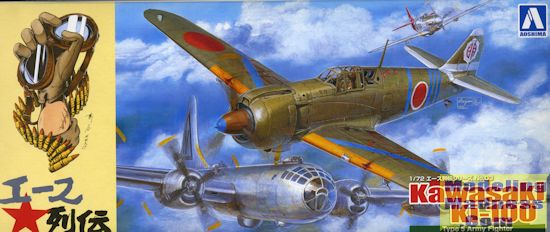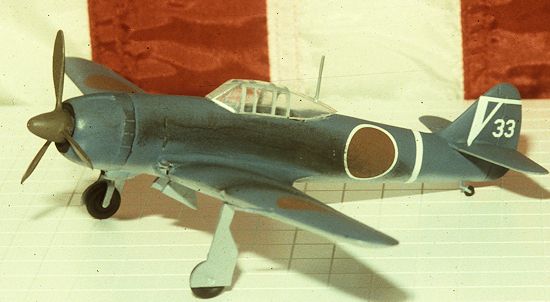
Aoshima 1/72 Ki-100
| KIT #: | 008140 |
| PRICE: | $ |
| DECALS: | Two options |
| REVIEWER: | Scott Van Aken |
| NOTES: |

| HISTORY |
In 1944, the folks at Kawasaki had a problem with the Ki-61. While airframe construction was going well, engine production was lagging far behind. So much so that there were airframes all over the factory awaiting engines. With a war going on, this was not considered to be a good thing. There was also the need to upgrade the engines in the Ki-61, but frankly, there were not enough engines around that were small enough and powerful enough to fit the need. Actually, the only suitable engine with enough power was a large 1,500 hp Mitsubishi 14 cylinder, double-row radial.
Deciding to give it a shot anyway, Kawasaki engineers went about trying to adapt a 4 foot wide engine into a 2 foot 9inch wide Ki-61. Some creative engineering and aerodynamic smoothing was applied and the engine was finally fit in, the first prototype flying in February of 1945. Much to everyone's delight, the aircraft that was produced was superior in almost every way to the Ki-61. It was lighter, more maneuverable, had better climbing speed and a higher ceiling. The only down side was that it was a few miles per hour slower. No big deal when the plan was to use it to get to the B-29s that were making themselves a major nuisance, what with bombing and all.
The superb handling and ease of flying gave even the most inexperienced pilots a chance against American fighters. In the hands of an expert, they were easily a match for anything the US could put against it. As was typical of late war projects, it was too little and too late. Nearly 400 were eventually built, over half of them modified Ki-61 airframes. Thankfully, one still exists in the UK and has been lovingly restored.
| THE KIT |
 This
is Aoshima's second attempt at doing a Ki-100, and truly, it is a TON better
than what they cranked out in the late 1960s (see photo at bottom of page). This
is the third boxing of the newer tool kit. Of the first two, one was the bubble
top version and the other had different decals. The molding of the kit is just
as you'd expect from a major kit maker and is nicely engraved panel lines.
This
is Aoshima's second attempt at doing a Ki-100, and truly, it is a TON better
than what they cranked out in the late 1960s (see photo at bottom of page). This
is the third boxing of the newer tool kit. Of the first two, one was the bubble
top version and the other had different decals. The molding of the kit is just
as you'd expect from a major kit maker and is nicely engraved panel lines.
The kit contains five sprues, one of which is for the clear bits. The cockpit contains a two piece seat, landing gear handle, control stick, side panels, rudder bar and an instrument panel that has the nose gun butts and gunsight. There is no decal for the instruments. This is trapped between the two fuselage halves along with the engine face. In this case it is the back set of cylinders, the full forward set being added later in the build. There is also a separate upper cowling piece into which the gun barrels fit.
The wing is a single lower piece with wheel wells and the upper wing halves fit onto this. Aoshima has let us decide if we want to install the drop tanks so one will have to be sure to open the holes if this is the case. One has plugs for the machine guns in the wing. There is a section that fits on the lower fuselage. This is pretty typical of all the Ki-100 kits I've seen, regardless of scale. The aforementioned drop tanks are complete with the rack on one tank half.
The tailplanes are a single piece. Landing gear are well done with a separate wheel for the main gear and the tail wheel molded in place for the tail gear. The main wheels are held in place by attaching the gear door. Inner gear doors for the main gear have separate retraction mechanisms. The separate set of forward cylinders is installed near the end of the build just before attaching the reduction gear housing and finally the single piece forward cowling. The prop is a single piece and trapped between a backing plate and the spinner. You are provided a separate windscreen, canopy and backlight piece. You also have separate landing light covers and very small formation lights.
Instructions are well drawn and while everything is in
Japanese, there should be no issues when it comes to building the kit or finding
bits. Gunze paint references are used. There are two sets of markings with this
kit. Both planes are in Kawasaki Army Green over unpainted metal, though the
underside color is never shown in the painting guide. Another color not included
in the painting chart is the primer brown of t he
prop. The primer grey-green of the lower flight control surfaces is also not
shown in the painting instructions. The first option is the rather flamboyant
scheme of the box art plane from the Akeno Flying School. The second is from the
244th Sentai. The decal sheet is nicely done with the proper color of red (often
Japanese decals make this red too bright). You are provided two colors of
walkway and warning decals as well as what looks like extra fuselage hinomarus.
The sheet also includes the leading edge ID stripes as well as those that fit on
the tailplanes of the first option. The modeler may want to consider painting
these areas as decals are notoriously difficult to get to fit properly on flight
surface leading edges.
he
prop. The primer grey-green of the lower flight control surfaces is also not
shown in the painting instructions. The first option is the rather flamboyant
scheme of the box art plane from the Akeno Flying School. The second is from the
244th Sentai. The decal sheet is nicely done with the proper color of red (often
Japanese decals make this red too bright). You are provided two colors of
walkway and warning decals as well as what looks like extra fuselage hinomarus.
The sheet also includes the leading edge ID stripes as well as those that fit on
the tailplanes of the first option. The modeler may want to consider painting
these areas as decals are notoriously difficult to get to fit properly on flight
surface leading edges.
| CONCLUSIONS |
 According
to my recall, this is the third Ki-100 kit done by a mainstream kit maker in
this scale. First was Aoshima's original boxing which, as you can see by the
image of the one I built back when, is only a passing resemblance to the real
thing. The other was the Fine Molds kit, which I found to be a bit tricky to
build, but very much looks the part. Now we have an even newer version and from
what I see, this is the best of the lot.
According
to my recall, this is the third Ki-100 kit done by a mainstream kit maker in
this scale. First was Aoshima's original boxing which, as you can see by the
image of the one I built back when, is only a passing resemblance to the real
thing. The other was the Fine Molds kit, which I found to be a bit tricky to
build, but very much looks the part. Now we have an even newer version and from
what I see, this is the best of the lot.
August 2015
Thanks to www.dragonmodelsusa.com for the preview kit. Get yours at your local shop or have them order it for you.
If you would like your product reviewed fairly and fairly quickly, please contact the editor or see other details in the Note to Contributors.